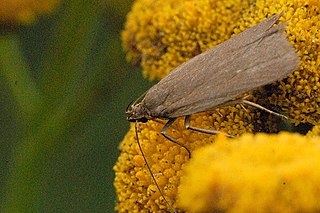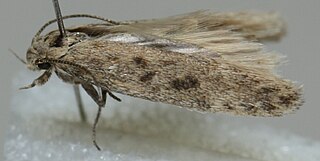
Scrobipalpa acuminatella is a moth of the family Gelechiidae. It is found in most of Europe, as well as Turkey, southern Siberia, Central Asia and China (Anhui). It was recently reported from Canada, with records from Ontario and Québec.

Scrobipalpa costella is a moth of the family Gelechiidae. It is found in western Europe.

Anarsia isogona is a moth of the family Gelechiidae. In 1933, it was described by Edward Meyrick. It is found in Japan, China, Taiwan and southern India.
Dichomeris acrochlora is a moth of the family Gelechiidae. It was described by Edward Meyrick in 1905. It is known from Sri Lanka and India.
Dichomeris albiscripta is a moth of the family Gelechiidae. It was described by Edward Meyrick in 1914. It is known from southern India.
Dichomeris amphichlora is a moth of the family Gelechiidae. It was described by Edward Meyrick in 1923. It is known from north-eastern India.
Dichomeris ampliata is a moth of the family Gelechiidae. It was described by Edward Meyrick in 1913. It is known from north-eastern India and Sri Lanka.
Dichomeris ampycota is a moth of the family Gelechiidae. It was described by Edward Meyrick in 1913. It is known from Sri Lanka.

Chionodes distinctella, the eastern groundling, is a moth of the family Gelechiidae. It is found in almost all of Europe, as well as most of Russia, Kazakhstan, Central Asia and North Africa. The habitat consists of dry, rocky heath and meadows and the verges and rough pastures.
Helcystogramma amethystium is a moth in the family Gelechiidae. It was described by Edward Meyrick in 1906. It is known from India and Sri Lanka.
Helcystogramma aruritis is a moth in the family Gelechiidae. It was described by Edward Meyrick in 1911. It is known from Sri Lanka.
Helcystogramma augusta is a moth in the family Gelechiidae. It was described by Edward Meyrick in 1911. It is known from north-eastern India.
Helcystogramma balteatum is a moth in the family Gelechiidae. It was described by Edward Meyrick in 1911. It is known from north-eastern India.
Helcystogramma crypsinomum is a moth in the family Gelechiidae. It was described by Edward Meyrick in 1929. It is known from Thailand.
Helcystogramma engraptum is a moth in the family Gelechiidae. It was described by Edward Meyrick in 1918. It is known from Pakistan and India.
Helcystogramma hoplophorum is a moth in the family Gelechiidae. It was described by Edward Meyrick in 1916. It is known from India, Sri Lanka, and Myanmar.
Helcystogramma idiastis is a moth in the family Gelechiidae. It was described by Edward Meyrick in 1916. It is known from north-eastern India.
Helcystogramma ineruditum is a moth in the family Gelechiidae. It was described by Edward Meyrick in 1926. It is found in Russia.
Helcystogramma infibulatum is a moth in the family Gelechiidae. It was described by Edward Meyrick in 1916. It is known from India and Sri Lanka.

Scrobipalpa obsoletella, the summer groundling, is a moth of the family Gelechiidae. It is found in most of Europe, Turkey, the Caucasus, from Iran to Asian Russia (Transbaikal) and Mongolia. It has also been recorded from New Zealand, South Africa and North America, where it is probably an introduced species. The habitat consists of coastal salt marshes and sandy beaches.



